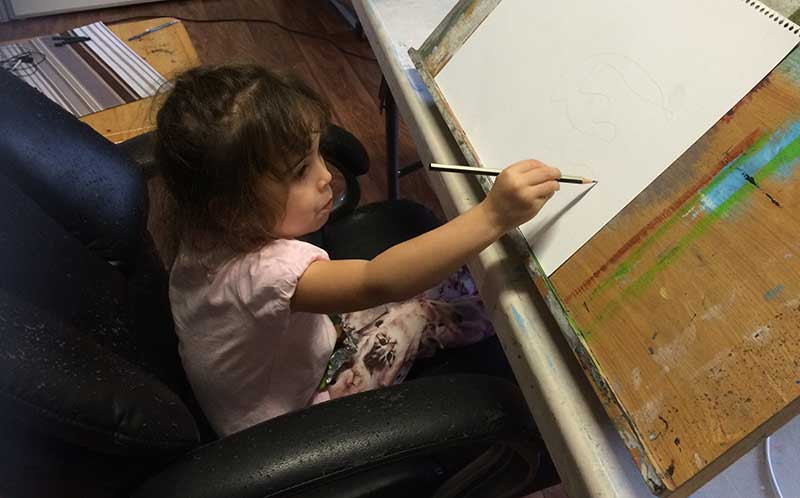Why can't I draw?

What is it that stops us from being able to draw? Why does it seem so easy for some people to draw while most people struggle with even basic stick figures? How can we change our thinking about drawing to allow us to be able to draw like an expert?
In order to find out why and to learn how to progress forward we need to take a step back in time…to re-learn what we have already learned and start to think like an artist. Lets take a look at our early childhood drawings to find out what stopped us from progressing our drawing skills and how we can fix it.
After we progress from our scribble stage, the first objects that we usually attempt to draw are simple shapes that we have seen others drawing. Our pencil skills haven’t developed yet and we are still trying to make sense of the world, and so we represent objects in the simplest way possible.
This is when we are taught to draw simple stick figures to represent people and perhaps a box with a triangle on top to represent a house etc. This is a normal progression as we start to develop skills in hand/eye coordination.

While doing this we are learning to represent real objects by drawing simple shapes that form symbols of the objects. That is what drawing is all about. It is about reproducing the appearance of an object with a few simple lines. Of course, at this stage in our skill development we are replacing any real object representation with purely imaginative symbols and simply claiming them to be an object or a person. These symbols that we can successfully draw put themselves into our logical mind as a representation of that object.
As our skills progress, these stick figures become more and more complex. We might start adding more features to them, such as circles for eyes, a big curve for a mouth etc etc. eventually they become complex mixture of lines representing clothing, hair, ears, hands and feet. Usually our parents and teachers can teach us this much, and we follow what other children are doing around us. The more visual reference that we are given, the more we try. During this stage we often come up with rather inventive ways to represent objects, but usually not very realistic because we are more concerned with telling a story or representing an object.

By the time that we have reached the age of 7 we have already realised that these symbols don’t look anything like the real objects that we have been trying to draw. The problem is that all of our drawing efforts so far have been about drawing our symbols and we don’t know any other way to recreate the objects that we are seeing. Normally people don’t know how to progress past this point in their drawing skills.
Our learning about the skill of drawing becomes somewhat limited after this point. Unless we are given encouragement to continue or have someone to teach us further skills most people don’t develop far beyond this point. Our primary school teachers often don't know how to draw themselves, let alone teach us how to do it. Drawing books can sometimes help, depending on your learning style and whether you take the time to read and learn from them. Unless you are naturally learning the skills through nothing more than luck that your mind is already perceiving the world in a way that allows you to draw it, there isn't much resource available to help you grow your skills. Therefore it is totally normal if you can confidently draw stick figures but not much more.
We also start to compare our skills against our friends and other classmates. If we perceive their drawings as better than ours we start to develop the feeling that we aren't very good at drawing and aren't worthy of being classified as an "artist". We also see many other people reach the same point as ourselves and also not develop any further, so we start to think of our skill level as normal and we start to accept that we just can't draw. For those classmates that may have developed better drawing skills, we tend to label them as gifted or talented and start to think of them as an exception.
For some reason, we all hold very high expectations of ourselves when it comes to drawing. Unless we can draw like a professional artist right from the get-go, we tend to think of ourselves as not being able to draw. The truth is that every artist that you are comparing yourself to has spent their entire life developing and refining their skills. So why should we be as good if we haven't yet gone through the training and development that the artist has?
That development for you starts here today! I am going to guide you through the necessary steps for you to develop a new way of thinking and observing that will allow you to draw. To do this, we need to start back at the beginning and re-train our mind in the skills of drawing.
I'm really excited about bringing you these lessons and I hope that you are excited to learn. Everything is about to change for you as you start to see the world as an artist. Lets get started with learning how to do that. The next lesson will show you how to start seeing the world in a way that allows you to draw it.
Select the 'continue' button on the top right of the page.